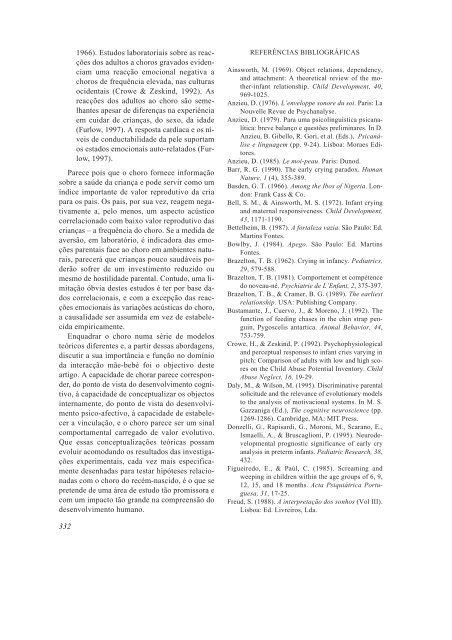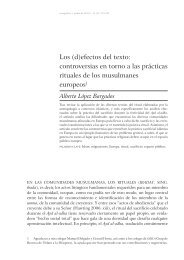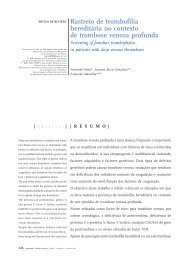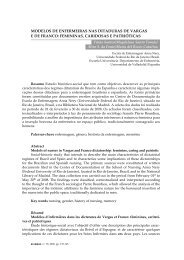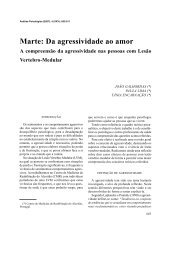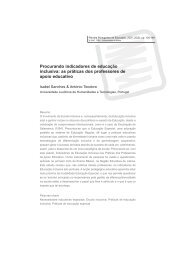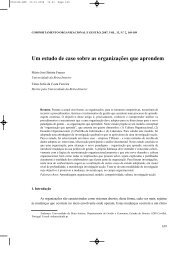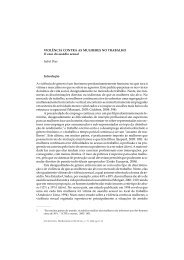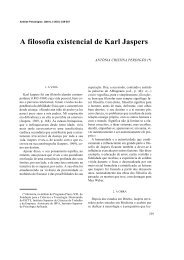Sobre o choro: Análise de perspectivas teóricas - SciELO
Sobre o choro: Análise de perspectivas teóricas - SciELO
Sobre o choro: Análise de perspectivas teóricas - SciELO
Create successful ePaper yourself
Turn your PDF publications into a flip-book with our unique Google optimized e-Paper software.
1966). Estudos laboratoriais sobre as reacções<br />
dos adultos a <strong>choro</strong>s gravados evi<strong>de</strong>nciam<br />
uma reacção emocional negativa a<br />
<strong>choro</strong>s <strong>de</strong> frequência elevada, nas culturas<br />
oci<strong>de</strong>ntais (Crowe & Zeskind, 1992). As<br />
reacções dos adultos ao <strong>choro</strong> são semelhantes<br />
apesar <strong>de</strong> diferenças na experiência<br />
em cuidar <strong>de</strong> crianças, do sexo, da ida<strong>de</strong><br />
(Furlow, 1997). A resposta cardíaca e os níveis<br />
<strong>de</strong> conductabilida<strong>de</strong> da pele suportam<br />
os estados emocionais auto-relatados (Furlow,<br />
1997).<br />
Parece pois que o <strong>choro</strong> fornece informação<br />
sobre a saú<strong>de</strong> da criança e po<strong>de</strong> servir como um<br />
índice importante <strong>de</strong> valor reprodutivo da cria<br />
para os pais. Os pais, por sua vez, reagem negativamente<br />
a, pelo menos, um aspecto acústico<br />
correlacionado com baixo valor reprodutivo das<br />
crianças – a frequência do <strong>choro</strong>. Se a medida <strong>de</strong><br />
aversão, em laboratório, é indicadora das emoções<br />
parentais face ao <strong>choro</strong> em ambientes naturais,<br />
parecerá que crianças pouco saudáveis po<strong>de</strong>rão<br />
sofrer <strong>de</strong> um investimento reduzido ou<br />
mesmo <strong>de</strong> hostilida<strong>de</strong> parental. Contudo, uma limitação<br />
óbvia <strong>de</strong>stes estudos é ter por base dados<br />
correlacionais, e com a excepção das reacções<br />
emocionais às variações acústicas do <strong>choro</strong>,<br />
a causalida<strong>de</strong> ser assumida em vez <strong>de</strong> estabelecida<br />
empiricamente.<br />
Enquadrar o <strong>choro</strong> numa série <strong>de</strong> mo<strong>de</strong>los<br />
teóricos diferentes e, a partir <strong>de</strong>ssas abordagens,<br />
discutir a sua importância e função no domínio<br />
da interacção mãe-bebé foi o objectivo <strong>de</strong>ste<br />
artigo. A capacida<strong>de</strong> <strong>de</strong> chorar parece correspon<strong>de</strong>r,<br />
do ponto <strong>de</strong> vista do <strong>de</strong>senvolvimento cognitivo,<br />
à capacida<strong>de</strong> <strong>de</strong> conceptualizar os objectos<br />
internamente, do ponto <strong>de</strong> vista do <strong>de</strong>senvolvimento<br />
psico-afectivo, à capacida<strong>de</strong> <strong>de</strong> estabelecer<br />
a vinculação, e o <strong>choro</strong> parece ser um sinal<br />
comportamental carregado <strong>de</strong> valor evolutivo.<br />
Que essas conceptualizações <strong>teóricas</strong> possam<br />
evoluir acomodando os resultados das investigações<br />
experimentais, cada vez mais especificamente<br />
<strong>de</strong>senhadas para testar hipóteses relacionadas<br />
com o <strong>choro</strong> do recém-nascido, é o que se<br />
preten<strong>de</strong> <strong>de</strong> uma área <strong>de</strong> estudo tão promissora e<br />
com um impacto tão gran<strong>de</strong> na compreensão do<br />
<strong>de</strong>senvolvimento humano.<br />
332<br />
REFERÊNCIAS BIBLIOGRÁFICAS<br />
Ainsworth, M. (1969). Object relations, <strong>de</strong>pen<strong>de</strong>ncy,<br />
and attachment: A theoretical review of the mother-infant<br />
relationship. Child Development, 40,<br />
969-1025.<br />
Anzieu, D. (1976). L’enveloppe sonore du soi. Paris: La<br />
Nouvelle Revue <strong>de</strong> Psychanalyse.<br />
Anzieu, D. (1979). Para uma psicolinguística psicanalítica:<br />
breve balanço e questões preliminares. In D.<br />
Anzieu, B. Gibello, R. Gori, et al. (Eds.), Psicanálise<br />
e linguagem (pp. 9-24). Lisboa: Moraes Editores.<br />
Anzieu, D. (1985). Le moi-peau. Paris: Dunod.<br />
Barr, R. G. (1990). The early crying paradox. Human<br />
Nature, 1 (4), 355-389.<br />
Bas<strong>de</strong>n, G. T. (1966). Among the Ibos of Nigeria. London:<br />
Frank Cass & Co.<br />
Bell, S. M., & Ainsworth, M. S. (1972). Infant crying<br />
and maternal responsiveness. Child Development,<br />
43, 1171-1190.<br />
Bettelheim, B. (1987). A fortaleza vazia. São Paulo: Ed.<br />
Martins Fontes.<br />
Bowlby, J. (1984). Apego. São Paulo: Ed. Martins<br />
Fontes.<br />
Brazelton, T. B. (1962). Crying in infancy. Pediatrics,<br />
29, 579-588.<br />
Brazelton, T. B. (1981). Comportement et compétence<br />
do noveau-né. Psychiatrie <strong>de</strong> L’Enfant, 2, 375-397.<br />
Brazelton, T. B., & Cramer, B. G. (1989). The earliest<br />
relationship. USA: Publishing Company.<br />
Bustamante, J., Cuervo, J., & Moreno, J. (1992). The<br />
function of feeding chases in the chin strap penguin,<br />
Pygoscelis antartica. Animal Behavior, 44,<br />
753-759.<br />
Crowe, H., & Zeskind, P. (1992). Psychophysiological<br />
and perceptual responses to infant cries varying in<br />
pitch: Comparison of adults with low and high scores<br />
on the Child Abuse Potential Inventory. Child<br />
Abuse Neglect, 16, 19-29.<br />
Daly, M., & Wilson, M. (1995). Discriminative parental<br />
solicitu<strong>de</strong> and the relevance of evolutionary mo<strong>de</strong>ls<br />
to the analysis of motivacional systems. In M. S.<br />
Gazzaniga (Ed.), The cognitive neuroscience (pp.<br />
1269-1286). Cambridge, MA: MIT Press.<br />
Donzelli, G., Rapisardi, G., Moroni, M., Scarano, E.,<br />
Ismaelli, A., & Bruscaglioni, P. (1995). Neuro<strong>de</strong>velopmental<br />
prognostic significance of early cry<br />
analysis in preterm infants. Pediatric Research, 38,<br />
432.<br />
Figueiredo, E., & Paúl, C. (1985). Screaming and<br />
weeping in children within the age groups of 6, 9,<br />
12, 15, and 18 months. Acta Psiquiátrica Portuguesa,<br />
31, 17-25.<br />
Freud, S. (1988). A interpretação dos sonhos (Vol III).<br />
Lisboa: Ed. Livreiros, Lda.


